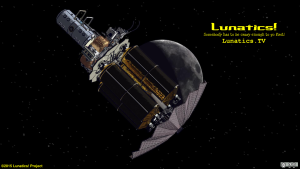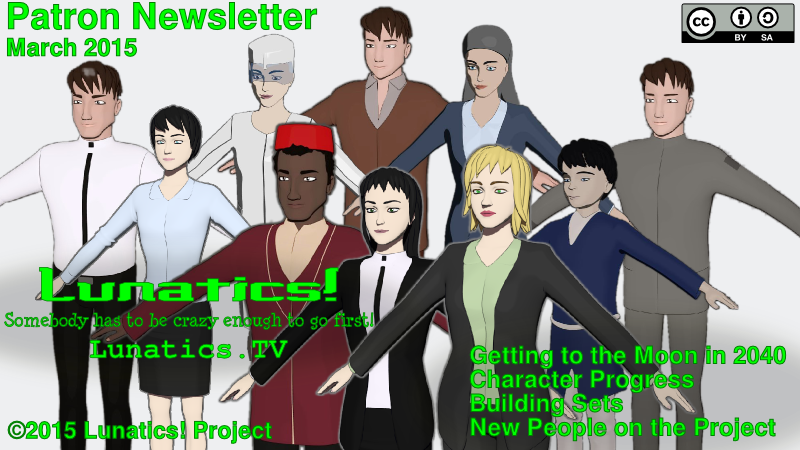Getting to the Moon in 2040
In our December issue, I addressed the design of the Lunar Transportation System. I didn’t say much about the fleet though, or what other options might exist — points I realized when I got a comment about the lander having a US flag on it. Of course, it is a provision of the UN Outer Space Treaty that every spacecraft has to have authorization from a responsible national government. This is true in 2015, and I expect it to be true in 2040.
So how many ways are there to get to the Moon in 2040? And what national flags do they carry?
Our story is now just 25 years in the future, so its world is very close to the real world we live in. There are still nation states, and, by-and-large, they are the same nation states we know today, although we extrapolate some changes we think are plausible, if not necessarily inevitable. We’re careful not to get too specific about events on Earth, but we need a concrete back story to keep things consistent.
Some extrapolations seem fairly safe. Some African nations, notably Nigeria, will have a bigger part in world politics, as a result of already-emerging tech sectors. The Middle East will have cooled down and stabilized substantially from today (how could it not?). Population is still flattening out, but still hasn’t quite reached zero population growth. Technology is much more widely available. Fossil fuels have peaked and are on the way out, though there are still a number of uses for them, including the Soyuz system’s rocket fuel. Synthetic fuels are common as are plug-in electric vehicles with more sophisticated batteries, and the overall power mix includes a lot of solar, wind, ocean, and nuclear power plants.
A kind of global social revolution happened in the 2020s, not unlike the one in the 1960s, releasing some of the tensions we can see building up in the world today. We’re not specific in how it was resolved, but the global economy rebounded in the 2030s partly as a result of greater political stability, and it’s largely riding this wave of economic success that made the return to the Moon and the idea of establishing bases and colonies there viable. There are a few signs of that wave of progress flagging in the 2040s, which is part of the backdrop in front of which our story plays out, creating some new tensions with indirect effects on our characters.
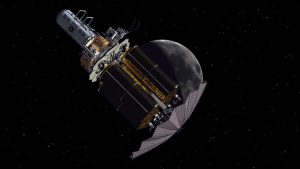
In space, we posit a newly-invigorated era of cooperation in the late 2020s and early 2030s, which resulted in the USA and Russia building the Lunar Transportation System to support both country’s ambitions on the Moon. Reflecting budgets and relative interest in lunar development, this is a somewhat US-dominated project, with five of the seven LTS shuttles built by the US, named after Apollo Lunar Module Pilots: Aldrin, Bean, Mitchell, Duke, and Schmitt (the Irwin having been decommissioned due to accidental damage, Haise being reserved for a new shuttle if one is built). The two Russian spacecraft are named after two landmark female cosmonauts, Tereshkova and Savitskaya.
This means the LTS fleet is slightly larger than the US Shuttle fleet was at the peak of the program, and follows a general rule of thumb idea for our story world: “In 2040, getting to the Moon will be about as hard as getting into orbit is today (or was during the Shuttle era)”. That gives us a somewhat realistic degree of isolation with concrete limits on resupply that we could design around, without making the task impossible.
We don’t mention the Chinese space program for quite some time, but the Chinese don’t use the LTS, and have their own independent Lunar support spacecraft. The European Union uses either the US or Russian LTS spacecraft, but do not have one under EU registry. They do, however, operate an unmanned ion-powered cargo tug that can deliver cargoes to the Moon independently for much less money than an LTS flight costs.
We need a specific backstory like this to set up the foreground events of our story in a way that is both plausible and concrete. And of course, about that flag — the shuttle in the pilot is the second one built, the Alan Bean. That’s a bit of a personal connection for me, because Bean was from my home town of Fort Worth, Texas, and his Apollo spacesuit was on display in the Fort Worth Museum of Science and History all during my space-obsessed childhood, so I have a fond memory of seeing it there whenever I visited the museum. Bean is also noteworthy among the Apollo astronauts for his artistic talents and paintings.
Character Progress
Development of the large number of “Walk-On” characters has been one of the biggest challenges for creating our pilot episode. We could’ve skipped this part of the story to save ourselves this trouble. But having the story start on Earth gives us an opportunity to establish a greater feeling of continuity with the present, which is one of the things that makes Lunatics special as science fiction.
The eight main characters for the story are being modeled by Bela Szabo. He also created a few “base mesh” characters on which to base the other characters. Having him do all of this was intended to increase the stylistic consistency of the characters.
However, based on these meshes, Keneisha Perry has been creating additional characters, with different clothes and hair, and in some cases, significant alterations to these meshes. She’s also applying the animation rigs to all of the characters as she goes. This is a huge job, which she has been making great progress at.
This is still a little bit of a work in progress, and we’re still applying and testing character rigs, but our cover this month is a sneak peek at the current state of these characters:
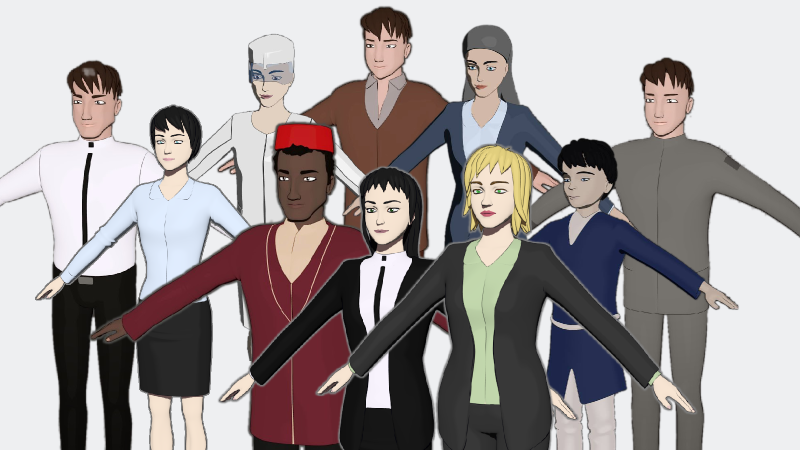
Of course, these are in “modified T-pose” with neutral faces. We’ll have some posed characters to show you soon, I hope.
Building Sets
Development of sets currently appears to be our limiting factor. I have not succeeded in finding people with much interest in this modeling task. Perhaps it’s perceived as less exciting than other modeling jobs for Lunatics. But of course, it’s very important.
Previous newsletters have shown my own best sets, which are the exterior sets of Baikonur and the Baikonur Cosmodrome that I have shown before.
Sathish Kumar has been working on the most important interior set for the Prolog (that is, Part 1 of the pilot, “No Children in Space”), which is our version of the “Aquarium Room” in Building 254 at the Baikonur Cosmodrome. This is the set for both the “Press Conference” and the “Suiting Up” scenes in the pilot. Here’s a couple of views of his blocking model:
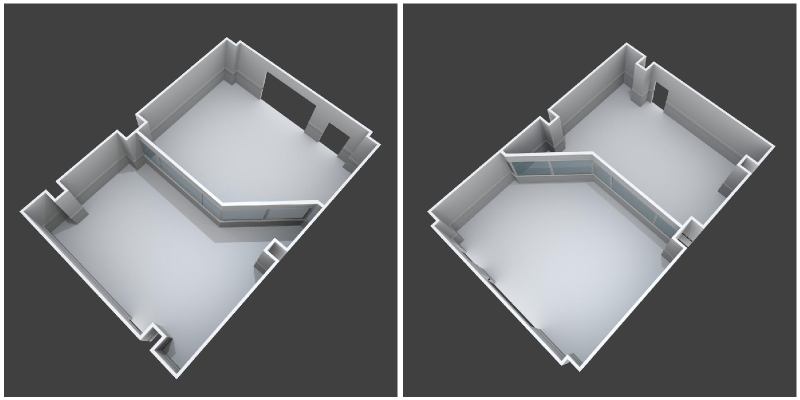
This room is nicknamed the “Aquarium Room” because of the large glass partition that keeps the astronauts quarantined from the press, so they don’t acquire any infectious diseases that might interfere with the launch or simply get carried up to the Space Station.
There are actually two press conferences before most Soyuz launches and there are two isolation rooms like this. One is at the Cosmonaut Hotel in the town of Baikonur, and is a much larger room. The animatic version of the pilot assumed the press conference scene would occur there.
However, further research shows that that conference is a lot more focused on the “top brass” with the astronauts relegated to a gallery on the side. This also gave us a need for a transition to the space port after the conference.
So I revised the script to set the press conference in this smaller room at the spaceport, which makes it into a more intimate setting, more focused on the space travelers themselves, and thus more in keeping with the way the scene is written and performed. This makes the transitions a little smoother and quicker, as well.
New People on the Project
What I’ve been doing for the last week or so is recruiting. It’s clear that it’s time to get some more people into the project, and as we still can’t promise any monetary reward, that can be a little tricky. But fortunately for us, there are people who are interested.
Elsa Balderrama – “Character Scripts and Animation”
The most prominent not-yet-announced new edition is Elsa Balderrama, who is a very multi-talented woman joining us from Mexico. She is a Python and web developer, a digital painter, and a character animator. All three are things of great use to us. Since she’s starting out by helping with our website redesign, she has not yet contributed any artistic work to the project yet. However, a look at her 2014 demo reel on YouTube should give you an idea of her impressive set of skills:
The plan is for her to help just over the next few days with theming our new WordPress instance on the website, which I am installing. After that, she’ll be working with the Python scripting we use in our character rigs as well as adapting a script to apply lip-sync files from Papagayo to our character’s faces. This is an important step for speeding up animation of character dialog.
She’ll later go on to use these scripts and her animation experience to work on animating characters, along with Keneisha Perry and myself.
She’s also going to be involved in texture painting and preparing cover and website art for the project.
Which is a lot! I am very happy to welcome Elsa to our project!
Others
I’m currently talking to a couple of other people, but I don’t want to mention names yet, as it’s not certain they are going to be working on the project. However, I can say that one is a set modeler and the other is a foley artist.
“Foley” is the sound that is performed to match animation (or live-action with missing sound). This typically includes things like footprints or clothes rustling, etc. It’s a subtle art which can bring a scene much more to life when it is done well. I’m excited by the prospect of having someone who can focus on doing that right.
Internships
I’m also in communication with the internship office at the California State University at Long Beach. This is Keneisha Perry’s school, where she has been getting some school credit for working on our project. What we’re looking into is opening up the program to a few more students, who would likely get involved this Summer, when we will (I hope) be working on Parts 2 and 3 of “No Children in Space”.
The only real hitch is that they are not accustomed to working with 100% telecommute internships, and so we have had to make the case that creative work on our project is as good an experience for students as fetching coffee at major studios in LA. I’m hoping we have a good case and I’m optimistic, but I have not heard back from them on approval as yet.
Obviously, it would be highly beneficial to us to have some interns working on the project then, probably working on modeling and dressing sets for Iridium Base and the ISF-1 Colony.
Other News
This has been a hectic month on Lunatics. The preview trailer has been quite successful at stirring up interest, although not a lot of monetary support.
- First Episode in May?
- The only bad news is that the release date for part 1 (the “Prolog” for “No Children in Space”) is probably going to be delayed into May. Due to the effort on recruiting and infrastructure improvement, I’ve not been keeping up with modeling sets, and it looks like it may be mostly Sathish and I who are making them, so that’s probably going to delay us.
- Website Changes
- We are switching the main site over to WordPress this month. We’re also making some changes on the project side of the site — I’m retiring the MediaWiki instance and installing a Resource Space DAMS to replace it and we’re installing a Mumble server for realtime teleconferencing.
- Monthly Subscriptions
- The new “Subscribe” button on the Lunatics! front page is replacing the monthly Patreon account, which was awkward and so-far unused. The new system is both simpler and cheaper for us. There are three options, starting at $3/month for this newsletter.
Things are really getting quite exciting now. I hope we can hang onto this momentum right through getting the three parts of the pilot completed this year!
